예외 처리 방식
오류 코드를 리턴하지 말고, 예외를 던져라
bad
public class DeviceController {
...
public void sendShutDown() {
DeviceHandle handle = getHandle(DEV1);
// Check the state of the device
if (handle != DeviceHandle.INVALID) {
// Save the device status to the record field
retrieveDeviceRecord(handle);
// If not suspended, shut down
if (record.getStatus() != DEVICE_SUSPENDED) {
pauseDevice(handel);
clearDeviceWorkQueue(handle);
closeDevice(handle);
} else {
logger.log("Device suspended. Unable to shut down");
}
} else {
logger.log("Invalid handle for: " + DEV1.toString());
}
}
...
}- 옛날에는 오류를 나타낼 때 에러코드를 던졌다.
- 하지만 예외를 던지는 것이 명확하고, 처리 흐름이 깔끔해진다.
good
public class DeviceController {
...
public void sendShutDown() {
try {
tryToShutDown();
} catch (DeviceShutDownError e) {
logger.log(e);
}
}
private void tryToShutDown() throws DeviceShutDownError {
DeviceHandle handle = getHandle(DEV1);
DeviceRecord record = retrieveDeviceRecord(handle);
pauseDevice(handle);
clearDeviceWorkQueue(handle);
closeDevice(handle);
}
private DeviceHandle getHandle(DeviceID id){
...
throw new DeviceShutDownError("Invalid handle for: " + id.toString());
...
}
}- 오류가 발생한 부분에서 예외를 던진다. (별도의 처리가 필요한 예외라면 checked exception으로 던진다.)
- checked exception에 대한 예외처리를 하지 않는다면 메서드 선언부에 throws를 명시해야 한다.
- 예외를 처리할 수 있는 곳에서 catch하여 처리한다.
Unchecked Exception을 사용하라
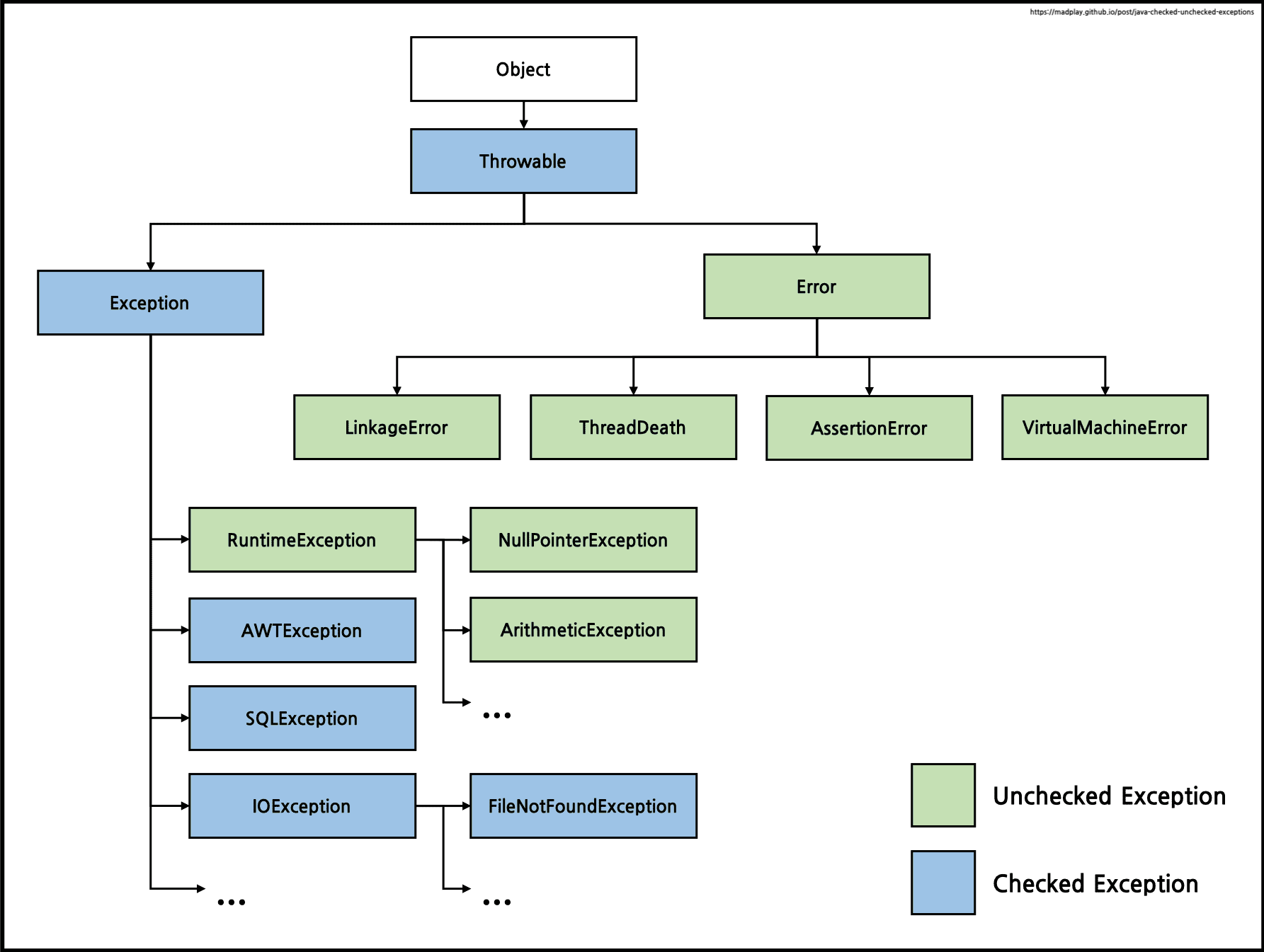
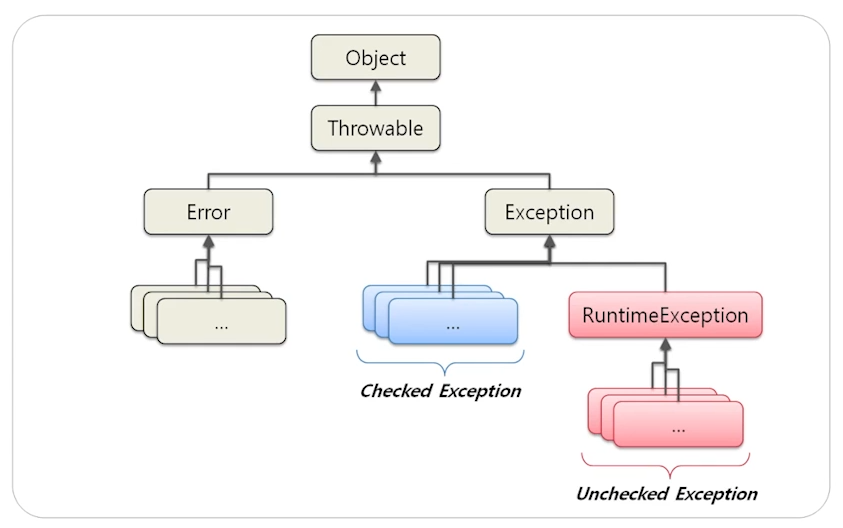
- Exception을 상속하면 Checked Exception 명시적인 예외처리가 필요하다.
- IOException, SQLException
- RuntimeException을 상속하면 UncheckedException 명시적인 예외처리가 필요하지 않다.
- NullPointerException, IllegalArgumentException, IndexOutOfBoundedException
Exceiption에 관한 규약
💡 자바 언어 명세가 요구하는 것은 아니지만, 업계에 널리 펴진 규약으로 Error 클래스를 상속해 하위 클래스를 만드는 일은 자제하자.즉, 사용자가 직접 구현하는 unchecked throwable은 모두 RuntimeException의 하위 클래스여야 한다.
Exception, RuntimeException, Error를 상속하지 않는 throwable을 만들 수도 있지만, 이러한 throwable은 정상적인 사항보다 나을 게 하나도 없으면서 API 사용자를 헷갈리게 할 뿐이므로 절대로 사용하지 말자.
안전적인 소프트웨어를 제작하는 요소로 확인된 예외가 반드시 필요하지는 않다는 사실이 분명해졌다.
C#은 확인된 예외를 지원하지 않는다. 영웅적인 시도에도 불고하고 C++ 역시 확인된 예외를 지원하지 않는다. 파이썬이나 루비도 마찬가지다.
그럼에도 불구하고 C#, C++, 파이썬, 루비는 안정적인 소프트웨어를 구현하기에 무리가 없다.
Exception 잘 쓰기
예외에 메시지를 담아라
예외에 의미있는 정보 담기
- 오류가 발생한 원인과 위치를 찾기 쉽도록, 예외를 던질 때는 전후 상황을 충분히 덧붙인다.
- 실패한 연산 이름과 유형 등 정보를 담아 예외를 던진다.
exception wrapper
bad
ACMEPort port = new ACMEPort(12);
try {
port.open();
} catch (DeviceResponseException e) {
reportPortError(e);
logger.log("Device response exception", e);
} catch (ATM1212UnlockedException e) {
reportPortError(e);
logger.log("Unlock exception", e);
} catch (GMXError e) {
reportPortError(e);
logger.log("Device response exception");
} finally {
...
}로그를 찍을 뿐 할 수 있는 일이 없다.
good
LocalPort port = new LocalPort(12);
try {
port.open();
} catch (PortDeviceFailure e) {
reportError(e);
logger.log(e.getMessage(), e);
} finally {
...
}
public class LocalPort {
private ACMEPort innerPort;
public LocalPort(int portNumber) {
innerPort = new ACMEPort(portNumber);
}
public void open() {
try {
innerPort.open();
} catch (DeviceResponseException e) {
throw new PortDeviceFailure(e);
} catch (ATM1212UnlockedException e) {
throw new PortDeviceFailure(e);
} catch (GMXError e) {
throw new PortDeviceFailure(e);
}
}
...
}예외를 감싸는 클래스를 만든다.
- port.open() 시 발생하는 checked exception들을 감싸도록 port를 가지는 LocalPort 클래스를 만든다.
- port.open()이 던지는 checked exception들을 하나의 PortDeviceFailure exception으로 감싸서 던진다.
실무 예외 처리 패턴
getOrElse
- 에외 대신 기본 값을 리턴한다.
- null이 아닌 기본 값
List<Employee> employees = getEmployees();
if (employees != null) {
for(Employee e : employees) {
totalPay += e.getPay();
}
}getEmployees를 설계할 때, 데이터가 없는 경우를 null로 표현했는데, 다른 방법이 있을까?
null을 리턴한다면 이후 코드에서 모두 null체크가 있어야 한다.
List<Employee> employees = getEmployees();
for(Employee e : employees) {
totalPay += e.getPay();
}
public List<Employee> getEmployees() {
if( .. there are no employees .. ){
return Collections.emptyList();
}
}복수형의 데이터를 가져올 때는 데이터의 없음을 의미하는 컬렉션을 리턴하면 된다.
null 보다 size가 0인 컬렉션이 훨씬 안전하다.
- 도메인에 맞는 기본 값
UserLevel userLevel = null;
try {
User user = userRepository.findByUserId(userId);
userLevel = user.getUserLevel();
} catch (UserNotFoundException e) {
userLevel = UserLevel.BASIC;
}
//userLevel을 이용한 처리호출부에서 예외 처리를 통해 userLevel 값을 처리한다.
코드를 계속 읽어나가면서 논리적인 흐름이 끊긴다.
UserLevel userLevel = userService.getUserLevelOrDefault(userId);
//userLevel을 이용한 처리
public class UserService {
private static final UserLevel USER_BASIC_LEVEL = UserLevel.BASIC;
public UserLevel getUserLevelOrDefault(Long userId) {
try {
User user = userRepository.findByUserId(userId);
return user.getUserLevel();
} catch (UserNotFoundException e) {
return USER_BASIC_LEVEL;
}
}
}예외 처리를 데이터를 제공하는 쪽에서 처리해 호출부 코드가 심플해진다.
코드를 읽어가며 논리적인 흐름이 끊기지 않는다.
도메인에 맞는 기본 값을 도메인 서비스에서 관리한다.
💡 도메인에 맞는 기본값이 없다면?getOrElseThrow
- null 대신 예외를 던진다. (기본 값이 없다면)
null 체크 지옥에서 벗어나자
public void registerItem(Item item) {
if (item != null) {
ItemRegistry registry = peristentStore.getItemRegistry();
if (registry != null)
Item existing = registry.getItem(item.getID());
if (existing.getBillingPeriod().hasRetailOwner()) {
existing.register(item);
}
}
}
}null 체크가 빠진 부분이 발생할 수 있다.
peristentStore 에 대한 null체크가 빠져있지만 알아챌 수 없다.
코드 가독성이 현저히 떨어진다.
User user = userRepository.findByUserId(userId);
if (user != null) {
// user를 이용한 처리
}user를 사용하는 쪽에서 매번 null 체크를 해야한다.
가독성뿐 아니라 안정성도 떨어진다.
User user = userService.getUserOrElseThrow(userId);
// user를 이용한 처리
public class UserService {
private static final UserLevel USER_BASIC_LEVEL = UserLevel.BASIC;
public User getUserOrElseThrow(Long userId) {
User user = userRepository.findByUserId(userId);
if (user == null) {
throw new IllegalArgumentException("User is not found. userId = " + userId);
}
return user;
}
}데이터를 제공하는 쪽에서 null 체크를 하여, 데이터가 없는 경우엔 예외를 던진다.
호출부에서 매번 null 체크를 할 필요 없이 안전하게 데이터를 사용할 수 있다.
호출부의 가독성이 올라간다.
파라미터의 null을 점검하라
public class MetricsCalculator {
public double xProjection(Point p1, Point p2) {
return (p2.x - p1.x) * 1.5;
}
}
// calculator.xProjection(null, new Point(12, 13));
// NullPointerException 발생한다.null을 리턴하는 것도 나쁘지만 null을 메서드로 넘기는 것은 더 나쁘다.
null을 메서드의 파라미터로 넣어야 하는 API를 사용하는 경우가 아니라면 null을 메서드로 넘기지 마라
null을 파라미터로 받지 못하게 한다.
public class MetricsCalculator {
public double xProjection(Point p1, Point p2) {
if(p1 == null || p2 == null) {
throw InvalidArgumentException("Invalid argument for MetricsCalculator.xProjection");
}
return (p2.x - p1.x) * 1.5
}
}null이 들어오면 unchekced exception을 발생시킨다.
public class MetricsCalculator {
public double xProjection(Point p1, Point p2) {
assert p1 != null : "p1 should not be null";
assert p2 != null : "p2 should not be null";
return (p2.x - p1.x) * 1.5;
}
}assert를 통해 null이 들어오면 에러를 발생시킨다.
실무에서는 보통 자신의 예외를 정의한다.
public class MyProjectException extends RuntimeException {
private MyErrorCode errorCode;
private String errorMessage;
public MyProjectException(MyErrorCode errorCode) {
// ..
}
public MyProjectException(MyErrorCode errorCode, String errorMessage) {
// ..
}
}
public enum MyErrorCode {
private String defaultErrorMessage;
INVALID_REQUEST("잘못된 요청입니다."),
DUPLICATE_REQUEST("기존 요청과 중복되어 처리할 수 없습니다."),
// ..
INTERNAL_SERVER_ERROR("처리 중 에러가 발생했습니다.");
}
// 호출부
if (request.getUserName() == null) {
throw new MyProjectException(ErrorCode.INVALID_REQUEST, "userName is null");
}장점
- 에러 로그에서 stacktrace 해봤을 때 우리가 발생시킨 예외라는 것을 바로 인지할 수 있다.
- 다른 라이브러리에서 발생한 에러와 섞이지 않는다. 우리도 IllegalArgumentException을 던지는 것보다 우리 예외로 던지는게 어느 부분에서 에러가 났는 지 파악하기에 용이하다.
- 우리 시스템에서 발생한 에러의 종류를 나열할 수 있다.
오픈소스 속 Exception 살펴보기
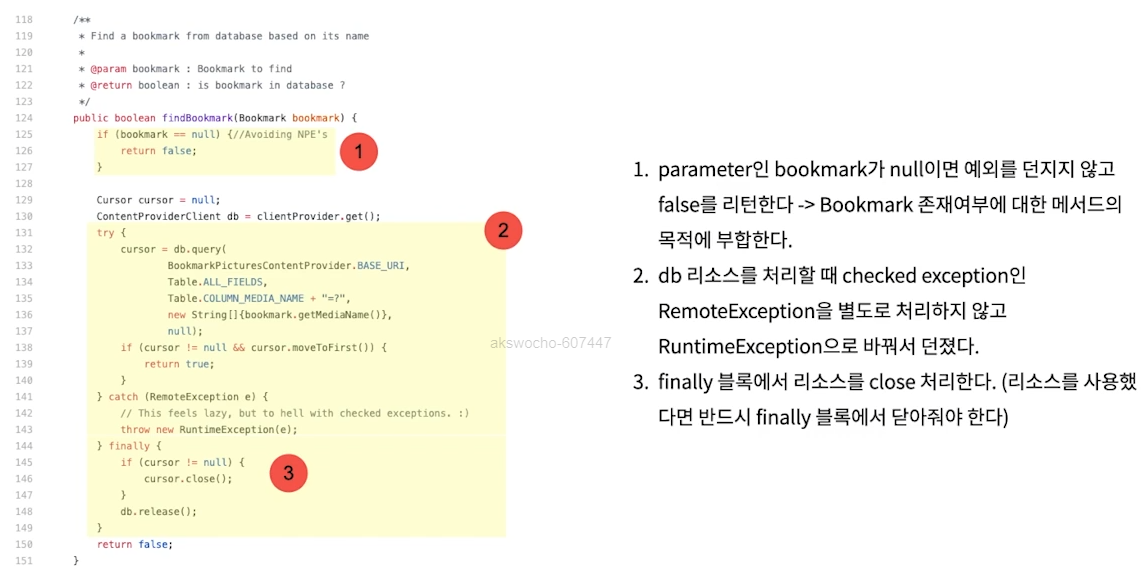
Elastic Search
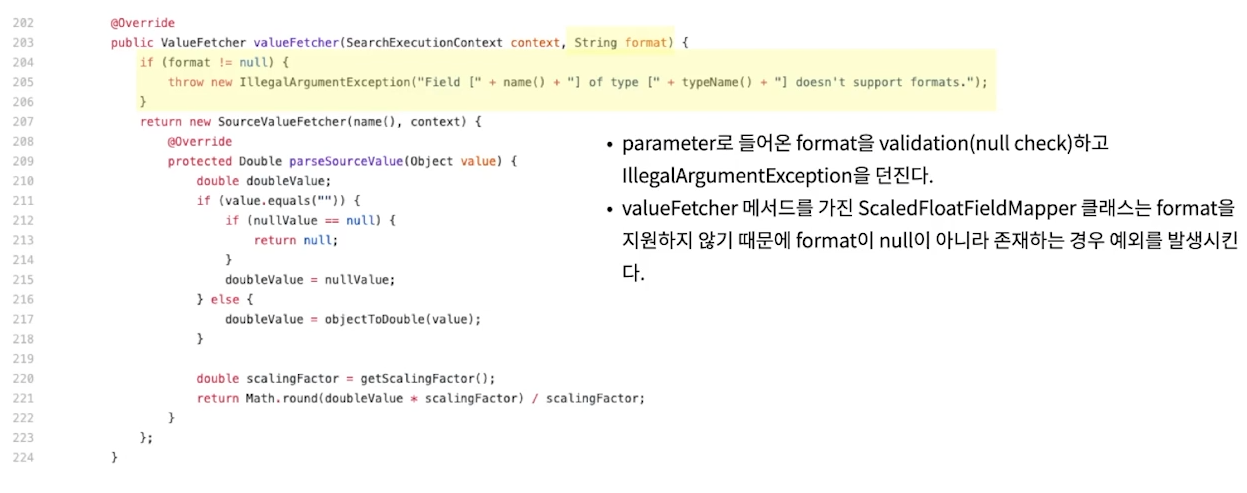
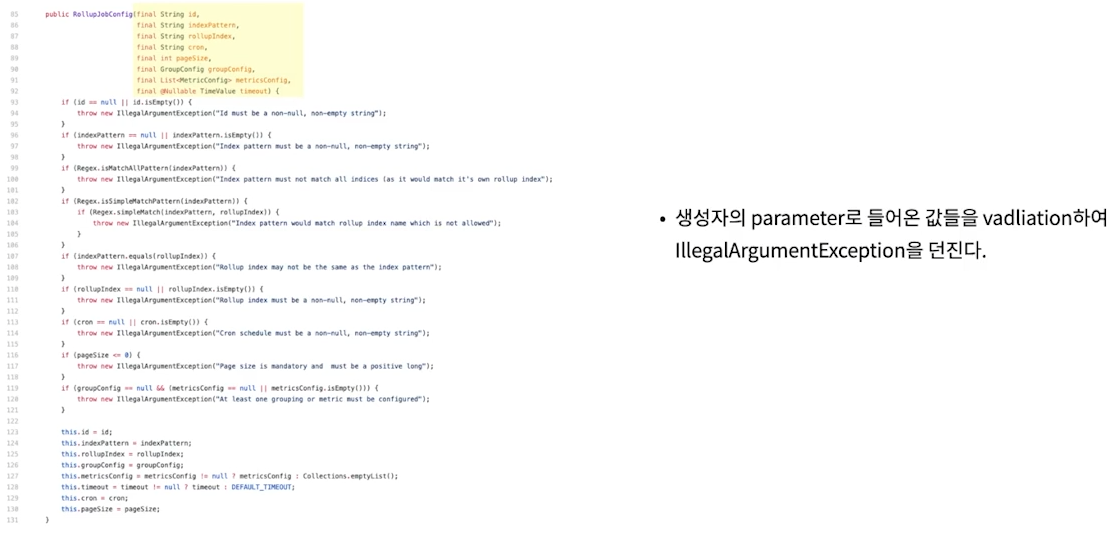
참고
해당 포스팅은 제로 베이스 클린코드 한달한권을 수강 후 정리한 내용입니다.

